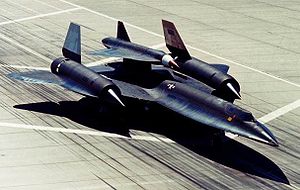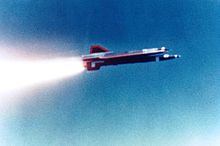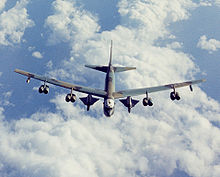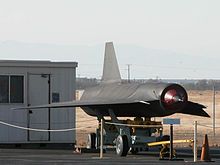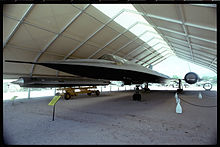- Lockheed D-21
-
D-21 The D-21 mounted on the back of the M-21. Note the intake cover on the drone, which was used on early flights. Role High-altitude reconnaissance drone National origin United States Manufacturer Lockheed First flight 22 December 1964 Introduction 1969 Retired 1971 Primary users Central Intelligence Agency
United States Air ForceNumber built 38 The Lockheed D-21 was an American Mach 3+ reconnaissance drone. The D-21 was initially designed to be launched from the back of its M-21 carrier aircraft, a variant of the Lockheed A-12 aircraft. Development began in October 1962. Originally known by the Lockheed designation Q-12, the drone was intended for reconnaissance missions deep in enemy airspace.
The D-21 was designed to carry a single high-resolution photographic camera over a preprogrammed path, then release the camera module into the air for retrieval, after which the drone would self-destruct.[1] Following a fatal accident when launched from an M-21, the D-21 was modified to be launched from a Boeing B-52 Stratofortress. Only four operational D-21 flights were made over the People's Republic of China before the program was canceled in 1971.
Contents
Design and development
In the 1960s, Lockheed's secret Skunk Works developed the Mach 3 A-12 reconnaissance aircraft for the Central Intelligence Agency (CIA). After the downing of Gary Powers's U-2 in 1960, a number of different concepts were proposed as alternatives. Kelly Johnson, the leader of Skunk Works, developed the concept of a long-range drone that used much of the A-12's technology. In October 1962, the CIA and the US Air Force instructed Lockheed to study a high-speed, high-altitude drone concept. Johnson specified speeds of Mach 3.3–3.5, an operational altitude of 87,000–95,000 feet (27,000–29,000 m), and a range of 3,000 nautical miles (3,500 mi; 5,600 km). It was intended to make a one-way trip, eject its camera payload at the end of the mission for recovery, then self-destruct.[2] It had a double-delta wing similar to the A-12's wing design. The Q-12 was to be air-launched from the back of an A-12, and used key technology from the A-12 project, including titanium construction and radar cross-section reduction design features.[3]
Johnson wanted to power the Q-12 with a ramjet engine built by Marquardt for the Boeing CIM-10 Bomarc long-range surface-to-air missile. Marquardt and Lockheed had already collaborated on several programs and had a close working relationship. The engine, the RJ43-MA-11, required modification, since it was only designed to burn as long as the missile needed to hit a target. In contrast, the Q-12's engine needed to operate at high temperatures for at least an hour and a half at high altitudes. The modified engine was designated as the RJ43-MA20S-4.[2]
A full-scale mockup of the Q-12 was ready by 7 December 1962, and had already undergone preliminary tests to measure its radar cross-section. Marquardt had also successfully tested the modified RJ-43 in its wind tunnel in the meantime.[4] However, the CIA was not enthusiastic about the Q-12, mostly because the agency was overextended at the time with U-2 missions, getting the A-12 up to speed, and covert operations in Southeast Asia. In contrast, the Air Force was interested in the Q-12 as both a reconnaissance platform and a cruise missile, and the CIA finally decided to work with the USAF to develop the new drone. Lockheed was awarded a contract in March 1963 for full-scale development of the Q-12.[3]
The camera and its film magazines with an inertial navigation system were carried in a cramped "Q-bay" below the drone's air intake. These components were built into a module that fit into the bay and was known as a "hatch". The hatch would be ejected at the end of the mission and then snagged out of the air by a JC-130 Hercules, a technique that had been developed by the Air Force to recover film canisters from satellites. If the C-130 missed, the hatch was equipped with flotation devices so it could be recovered by ship. Honeywell built the avionics systems; new construction techniques and materials had to be developed for the systems to withstand the high temperatures, extreme vibrations, and lack of space in the D-21.[5]
In late 1963, the project was named Tagboard; the Q-12 was re-designated D-21 while the A-12 version became M-21 (D- for "daughter" and M- for "mother"). Two of the original 18 A-12 aircraft were designated as M-21s with serial numbers 60-6940 and 60-6941. The M-21 was a two-seat version of the A-12, with a pylon on the fuselage centerline between the vertical stabilizers to carry the drone in a nose-up attitude.[6]
Testing and carrier change
A D-21 mounted on an M-21 began captive flight-testing on 22 December 1964. Aerodynamic covers were initially placed over the D-21's intake and exhaust to reduce drag, but had to be removed after the first few tests, as a method of discarding them at Mach 3 without damaging the M-21 or D-21 could not be devised.[7]
The D-21 was first successfully launched from an M-21 on 5 March 1966.[8] The drone was released successfully, but stayed close to the M-21's back for a few seconds, which seemed like "two hours" to the M-21 crew.[9] A second successful launch took place on 27 April 1966, with the D-21 reaching its operational altitude of 90,000 feet (27,400 m) and speed of over Mach 3.3, though it was lost due to a hydraulic pump failure after a flight of over 1,200 nmi (1,400 mi; 2,200 km). The Air Force's interest in the program continued and more D-21s were ordered after the second launch.[8] A third successful flight took place on 16 June, with the D-21 flying 1,550 nmi (1,780 mi; 2,870 km) through its complete flight profile, though its camera hatch was not released due to an electronics failure.[10]
The fourth and final launch from an M-21 on 30 July ended in disaster. Unlike the three previous launches this one was performed straight and level, not in an outside loop to assist in the separation of the drone from the aircraft. The D-21 suffered engine problems and struck the M-21's tail immediately after separation, which led to the destruction of both aircraft. The two crew ejected, and landed at sea. The pilot, Bill Park, survived, but the Launch Control Officer, Ray Torick, drowned.[10][11]
Following the accident, Johnson suggested launching the D-21 from a larger aircraft, the Boeing B-52 Stratofortress, and adding a solid rocket booster to get it up to speed.[12] The drone was modified by adding attachment points on its spine to mate with the carrying pylon on the B-52 and its belly attachment points were adapted to accommodate the rocket booster necessary to increase its speed and allow its ramjet to operate. Its vertical stabilizer was increased in size by approximately 20%. The modified drone version was designated D-21B, although there was no -21A version. Two B-52Hs were modified to carry a pair of drones each by means of two large underwing pylons that replaced the smaller pylons used for the AGM-28 Hound Dog cruise missiles. The tail gunner's and electronic warfare officer's stations were replaced with two launch control stations. Command and telemetry systems were added, and high-speed cameras were installed to track the drones as they separated from the pylons. The B-52Hs could communicate with the D-21Bs, which had remote control links so that the launch control officer could order it to self-destruct if necessary.[13]
The solid-fuel booster was both larger and heavier than the drone; it was 44 feet 4 inches (13.5 m) long and weighed 13,286 pounds (6,030 kg). It had a folding tail fin on the bottom to stabilize it while the rocket was firing. The booster had a burn time of 87 seconds, and a thrust of 27,300 pounds-force (121 kN).[14] During ground handling, everyone within 25 feet (7.6 m) was required to wear anti-static straps to prevent any discharge of static electricity from igniting the booster.[15]
The first attempted launch of a D-21B was on 28 September 1967, but the drone accidentally fell off the B-52's launch pylon due to a stripped nut on the pylon before the aircraft reached its intended launch point. Johnson admitted that the incident was "very embarrassing". Three more launches were performed from November 1967 through January 1968. None were completely successful, so Johnson ordered his team to conduct a thorough review before renewing launch attempts.[16] The next launch was on 10 April 1968, and was also a failure because the engine did not ignite. On 16 June, the D-21B finally made a completely successful flight as it flew at the specified altitude and course for its full range and the hatch was recovered successfully.[17] The next two launches were failures, followed by another successful flight in December. A test in February 1969 to check the inertial navigation system with an actual mission profile was a failure, and the next two flights in May and July succeeded.[18]
Operational history
Four operational missions with the D-21B took place under the codename of Senior Bowl. These were conducted over the People's Republic of China from 9 November 1969 to 20 March 1971 to spy on the Lop Nor nuclear test site. The USAF's 4200th Support Squadron, based at Beale Air Force Base, California, flew the missions, usually from Andersen Air Force Base in Guam.[19]
The Chinese never spotted the D-21B, but it failed to turn around and continued straight on, crashing somewhere in the Soviet Union.[20] Another test flight was conducted on 20 February 1970 in a successful attempt to correct any problems. The second operational mission, however, was not until 16 December 1970. The D-21B made it all the way to Lop Nor and back to the recovery point, but the hatch had a partial parachute failure and was lost at sea.[17]
During the third operational mission, on 4 March 1971, the D-21B flew to Lop Nor and returned, jettisoning the hatch. It deployed its parachute, but the midair recovery failed. The destroyer that tried to retrieve the hatch from the water ran it down and it sank. The fourth, and last, flight of the D-21B was on 20 March 1971. It was lost over China on the final segment of the route.[21] Wreckage of this lost D-21B was found by local authority in Yunnan province, China. In 2010, after being dumped in junkyard of China Aviation Museum for years, the wreckage was finally officially moved to exhibition area.[22]
On 23 July 1971, the D-21B program was canceled, due to the poor success rate, the introduction of a new generation of photo reconnaissance satellites, and President Richard Nixon's rapprochement with China.[23] A total of 38 D-21 and D-21B drones were built with 21 expended in launches. The remaining 17 were initially stored at Norton Air Force Base, California, then moved to Davis-Monthan Air Force Base "boneyard" near Tucson, Arizona,[24] in 1976 and 1977. With the base open to the public, the D-21 drones were quickly spotted and photographed. The Air Force called them GTD-21Bs with the GT standing for Ground Training.[25]
The fate of the D-21 that had disappeared on the first operational flight was finally revealed in February 1986 when an official from the CIA returned a panel to Ben Rich that he had been given by a Soviet KGB agent. The drone had self-destructed over Siberia and the Soviets had recovered the wreckage.[26] The Tupolev design bureau reverse-engineered the wreck and came up with plans for a Soviet copy, named the Voron (Raven), but it was never built.[27]
In the late 1990s, NASA considered using a D-21 to test a hybrid "rocket-based combined cycle" engine, which operates as a ramjet or rocket, depending on its flight regime. This idea was abandoned, and NASA used a derivative of the agency's X-43A hypersonic test vehicle for the experiments.[28]
Aircraft on display
- Chinese Aviation Museum, Beijing, China (D-21 #527)[29]
- Aerospace Maintenance and Regeneration Group (AMARG) located on Davis-Monthan AFB, Tucson, Arizona (D-21 #530)[30]
- Blackbird Airpark, Palmdale, California (D-21B #525)[30]
- Evergreen Aviation Museum, McMinnville, Oregon (GTD-21B)[31]
- Grissom Air Museum, Grissom Air Reserve Base, Peru, Indiana (GTD-21B)[32]
- March Field Air Museum, March Air Reserve Base, Riverside, California (D-21B #537)[33]
- Museum of Aviation, Robins Air Force Base, Georgia (GTD-21B #538)[34]
- Museum of Flight, Seattle, Washington (D-21 No. 510 mounted on remaining M-21 #60-6940)[35]
- National Museum of the United States Air Force, Wright-Patterson Air Force Base, Ohio (D-21B)[36]
- Pima Air & Space Museum (adjacent to Davis-Monthan AFB), Tucson, Arizona (D-21B #533) (Under restoration as of 15 March 2011)[37]
Specifications (D-21)
- D-21A and D-21B without booster
- Wingspan: 19 ft 1/4 in (5.79 m)
- Length: 42 ft 10 in (12.8 m)
- Height: 7 ft 1/4 in (2.14 m)
- Launch weight: 11,000 lb (5,000 kg)
- Maximum speed: Mach 3.35 (2,210 mph, 1,920 knots, 3,560 km/h)
- Service ceiling: 95,000 ft (29,000 m)
- Range: 3,000 nmi, 3,450 mi, 5,550 km
- Engine: 1 x Marquardt RJ43-MA-20S4 ramjet, 1,500 lbf (6.67 kN)
Sources: Pace,[38] Landis & Jenkins,[39] Donald[40]
See also
- Related development
- Lockheed A-12
- Lockheed YF-12
- Lockheed SR-71 Blackbird
- Related lists
References
- Notes
- ^ Donald 2003, pp. 154–56.
- ^ a b Goodall and Goodall 2002, p. 106.
- ^ a b Pace 2004, p. 55.
- ^ Goodall and Goodall 2002, pp. 106–107.
- ^ Goodall and Goodall 2002, pp. 112–114.
- ^ Goodall and Goodall 2002, p. 107.
- ^ Goodall and Goodall 2002, p. 109.
- ^ a b Donald 2003, p. 155.
- ^ Peebles 1999, p. 125.
- ^ a b Goodall and Goodall 2002, p. 108.
- ^ Landis and Jenkins 2005, pp. 24–25.
- ^ Landis and Jenkins 2005, pp. 25–26.
- ^ Goodall and Goodall 2002, pp. 109, 113, 117.
- ^ Peebles 1999, p. 127.
- ^ Goodall and Goodall 2002, pp. 115–116.
- ^ Peebles 1999, p. 129.
- ^ a b Goodall and Goodall 2002, p. 118.
- ^ Miller 1995, p. 141.
- ^ Goodall and Goodall 2002, pp. 112, 118.
- ^ "Interview with James A. Cunningham, Jr. (Director of Development Projects Division)". CIA. 4 October 1983. http://www.lazygranch.com/images/cia/jac/jac37s.jp2.
- ^ Peebles 1999, p. 131.
- ^ "Lockheed D-21B No. 527 now in China Aviation Museum", 29 August 2011.
- ^ Peebles 1999, pp. 133–34.
- ^ Landis and Jenkins 2005, p. 28.
- ^ Peebles 1999, p. 132.
- ^ Peebles 1999, p. 134.
- ^ Gordon and Rigamant 2005, pp. 325–27.
- ^ Landis and Jenkins 2005, pp. 28–29.
- ^ "Lockheed D-21 No. 527 SR-71 Drone". flickr.com, 5 August 2010.
- ^ a b Pace 2004, p. 64.
- ^ "Support Aircraft". Evergreen Aviation Museum. http://www.evergreenmuseum.org/#/aircraft-exhibits/military-aircraft/support-aircraft. Retrieved 15 March 2011.
- ^ "Lockheed GTD-21 Tagboard Drone". Grissom Air Museum. http://www.grissomairmuseum.com/?page_id=341. Retrieved 15 March 2011.
- ^ "Lockheed D-21B (#537) Drone". March Field Air Museum. http://www.marchfield.org/d21drone.htm. Retrieved 15 March 2011.
- ^ "Lockheed D-21B Unmanned Aerial Vehicle (UAV)". Museum of Aviation. http://www.museumofaviation.org/D21.php. Retrieved 5 April 2011.
- ^ "Lockheed D-21B Drone". The Museum of Flight. http://www.museumofflight.org/aircraft/lockheed-d-21b-drone. Retrieved 5 April 2011.
- ^ "U.S. Air Force Fact Sheet Lockheed D-21B". National Museum of the US Air Force. http://www.nationalmuseum.af.mil/factsheets/factsheet_print.asp?fsID=396&page=1. Retrieved 2 September 2011.
- ^ "Lockheed D-21B". Pima Air & Space Museum. http://www.pimaair.org/collection-detail.php?cid=151. Retrieved 15 March 2011.
- ^ Pace 2004, p. 63.
- ^ Landis and Jenkins 2005, pp. 23–25.
- ^ Donald 2003, pp. 154–55.
- Bibliography
- Donald, David, ed (2003). "Lockheed's Blackbirds: A-12, YF-12 and SR-71". Black Jets. Norwalk, Conneticut: AIRtime Publishing. ISBN 1-880588-67-6.
- Goodall, James C. and Nora D. (2002). "Senior Bowl–the Lockeed D-21". International Air Power Review (Norwalk, Conneticut: AIRtime Publishing) 3: 106–119. ISSN 1473-9917.
- Gordon, Yefim; Rigamant, Vladimir (2005). OKB Tupolev: A History of the Design Bureau and its Aircraft. Hinckley, England: Midland Publishing. ISBN 1-85780-214-4.
- Landis, Tony R.; Dennis R. Jenkins (2005). Lockheed Blackbirds. Warbird Tech. 10 (Revised ed.). North Branch, Minnesota: Specialty Press. ISBN 1-58007-086-8.
- Miller, Jay (1995). Lockheed Martin's Skunk Works (Revised ed.). Leicester, England: Midland Publishing. ISBN 1-85780-037-0.
- Pace, Steve (2004). Lockheed SR-71 Blackbird. Swindon: Crowood Press. ISBN 1-86126-697-9.
- Peebles, Curtiss (1999). Dark Eagles: A History of Top Secret U.S. Aircraft Programs (Revised ed.). Novato, California: Presidio Press. ISBN 0-89141-696-X.
- Rich, Ben; Janos, Leo (1996). Skunk Works. Boston: Little, Brown & Company. ISBN 0-316-74300-3.
External links
- USAF Aircraft Serial Numbers for 1960, including all A-12s, YF-12As and M-21s
- Loss of M-21 and D-21, including video of successful launches and the midair collision
- Directory of U.S. Military Rockets and Missiles
- Weapons of Precise Destruction
- Photos of Lockheed D-21B No. 527 in China Aviation Museum, Beijing
Lockheed and Lockheed Martin aircraft Manufacturer
designationsBasic Model
NumbersL-1 · L-2 · L-3 · L-4 · L-5 · L-7 · L-8 · L-9 · L-10 · L-11 · L-012 · (L-013 not assigned) · L-014 · L-015 · L-016 · L-017 · L-018 · L-019 · L-020 · L-021 · L-022 · L-023 · L-024 · (L-025 not assigned) · L-026 · L-027 · (L-028 not assigned) · L-029 · L-030 · L-031 · L-032 · L-033 · L-034 · L-035 · (L-036 not assigned) · L-037 · (L-038 and L-039 not assigned) · L-040 · L-041 · L-042 · L-044 · L-045 · L-049 · L-050 · L-051 · L-052 · L-060 · L-061 · L-062 · L-075 · L-080 · L-081 · L-082 · L-083 · L-084 · L-085 · L-086 · L-087 · L-088 · L-089 · L-090 · L-091 · L-092 · L-093 · L-094 · L-092 · L-099 · L-100 · L-133 · L-193 · L-245 · L-246 · L-300 · L-301 · L-329 · L-351 · L-382 · L-500 · L-645
Lockheed-California
Temporary Design
NumbersBy role Airliners and
civil transportsVega · Sirius · Altair · Orion · Electra · Electra Junior · Super Electra · Lodestar · Constellation (L-049 · L-649 · L-749) · Super Constellation (L-1049 · L-1249) · Starliner · Saturn · Electra · L-402 · JetStar · L-100 · L-1011
Military transportsY1C-12 · Y1C-17 · Y1C-23 · Y1C-25 · C-36 · C-37 · C-40 · C-56 · C-57 · C-59 · C-60 · C-63 · C-66 · C-69 · UC-85 · UC-101 · C-104 · C-111 · C-121 · C-130 / C-130J / HC-130 / KC-130 / LC-130 / MC-130 · C-139 · C-140 · C-141 · C-5 · JO · XRO · R2O · R3O · XR4O · R5O · R6O / R6V · R7O / R7V · R8V / GV / UV · TriStar
Attack and bombersDrones/UAVsEW and
reconnaissanceFightersHelicoptersMaritime patrolTrainersExperimentalNames Air Express · Aquila · Altair · Aurora · Big Dipper · Blackbird · Chain Lightning · Cheyenne · Constellation (L-049 · L-649 · L-749) · Constitution · Electra (Model 10) · Electra (Model 88) · Electra Junior · Excalibur · Explorer · Fighting Falcon · Galaxy · Have Blue · Hercules · Hudson · Hummingbird · JetStar · Kestrel · Kingfisher · Lightning · Lightning II · Little Dipper · Lodestar · Neptune · Orion (Model 9) · Orion (P-3) · Polecat · Raptor · Saturn · SeaStar · Sentinel · Shooting Star · Sirius · Starfighter · Starfire · Starlifter · Starliner · Super Constellation (L-1049 · L-1249) · Super Electra · Super Galaxy · Super Hercules · Tristar · Vega · Ventura · Viking · Warning Star
Lists relating to aviation General Aircraft (manufacturers) · Aircraft engines (manufacturers) · Airlines (defunct) · Airports · Civil authorities · Museums · Registration prefixes · Rotorcraft (manufacturers) · TimelineMilitary Accidents/incidents Records Categories:- UAVs and drones of the United States
- Parasite aircraft
- United States military reconnaissance aircraft 1960–1969
- Stealth aircraft
- Ramjet-powered aircraft
- Lockheed aircraft
- Black projects
Wikimedia Foundation. 2010.

